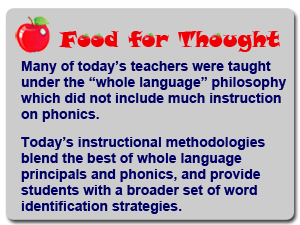What is phonics?
Phonics is a way to teach students how to decode text. This decoding is accomplished by associating written symbols to the spoken sounds that they understand. This process is known by a number of different terms including:
- Sound/symbol correspondence
- Spoken/written correspondence
- Phoneme/grapheme correspondence
Unlike many languages, the English language does not have strict phoneme/grapheme correspondence (where one sound is represented by only one symbol.) As a result, phonics rules have many exceptions and students will not always be able to use phonics to decode unknown words.

Why teach phonics?
Phonics is an integral part of learning to decode words and both the NRP and the IRA recommend teaching phonics to beginning readers.
Applying phonics generalizations helps beginning readers with pronunciation.
Even if a student cannot figure out the exact pronunciation using phonics, he or she will often come close to recognize the word within the context of a sentence.
Phonics is a decoding tool and should be taught in conjunction with “sight words,” “context clues,” and other decoding tools. We will be looking at these additional word identification strategies in the next module.
